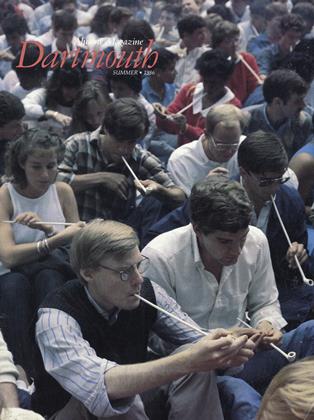The College's collection of material on members of an artists' colony that thrived for 35 years in Cornish, N.H., has for some time been highly regarded. But with the recent gift to Baker Library of the papers of artists Stephen and Maxfield Parrish, Dartmouth's Cornish colony collection becomes the best anywhere, according to Philip Cronenwett, chief of special collections at Baker.
Both Stephen Parrish (1846-1938) and his son Maxfield (1870-1966) were noted members of the Cornish colony, located just 15 miles south of Hanover. A major focus of art and literature nationwide between 1885 and 1920, according to Cronenwett, the Cornish group was one of the premiere artists' and writers' colony of its day in the United States. Maxfield Parrish, a well-known commercial illustrator of the time, is also highly regarded as a serious artist. His father, considered by some the superior artist, was a master engraver and landscape painter whose work is in increasing demand.
The bulk of the collection recently acquired by Baker is made up of photographs including 22 cartons of glass negatives which Maxfield used in composing his paintings. He often took pictures of backgrounds, then superimposed photos of models on the backgrounds. These negatives "are critical to figuring out what he was doing and why he was doing it," explains Cronenwett. Also in the collection are original sketches the younger Parrish used in preparing many of his major works; his extensive diaries from 1930 to 1957; nine linear feet of his correspondence dating from early in the century until his death, at age 95; his daybooks from 1892 to 1901, pertaining to his artistic works; color reproductions of many of his works; and most of the books he illustrated. Items of Stephen Parrish's in the collection include two sketchbooks one he gave to Maxfield in 1873 and one from 1887-88; the Parrish family letters from 1837 to 1890, a major source of information on 19th-century life in Philadelphia; records of the artist's paintings and sketches from 1877 to 1915; and a catalogue of his etchings.
The collection was given to Dartmouth by several members of the Parrish family. With this addition to the College's holdings, Cronenwett says that Dartmouth has papers from all the major members of the Cornish colony. He notes that the collections "make much more sense in context" because of the interrelationships between the members of the colony, which also included sculptor Augustus Saint-Gaudens and novelist Winston Churchill. "The whole is much greater than the sum of its parts," concludes Cronenwett.
"Ecstasy" is the title of this work by MaxfieldParrish, done for a 1930 General Electric promotional calendar. A photograph of the painting is one of many items in the recent collectiongiven to Baker by the Parrish family.
 View Full Issue
View Full Issue
More From This Issue
-
 Feature
FeatureYou Laughed
June 1986 By Nancy Wasserman '77 -
 Feature
FeatureCOMMENCEMENT
June 1986 -
 Feature
FeatureReunions 1986
June 1986 By Richard Hovey -
 Article
ArticleErik and Kris Hagerman: A tale of two seniors
June 1986 By Lee McDavid -
 Article
Article"More than Teacher"
June 1986 By Dorothy L. Foley '86 -
 Article
ArticleStephen W. Bosworth '61: Public servant in the spotlight
June 1986 By Robert H. Conn '61
Article
-
 Article
ArticlePRESIDENT HOPKINS
April, 1925 -
 Article
ArticleThe College
November 1974 -
 Article
ArticleForgotten Dartmouth Men
June 1936 By H. Sheridan Baketel, M.D. '95 -
 Article
ArticleThis article, first printed in the September-October 1967
JANUARY 1968 By M.R. -
 Article
ArticleSailing
MAY 1957 By Mal Clarke ‘57 -
 Article
ArticleNorth Shore
MARCH 1972 By RICHARD M. SHRIBMAN '47

